 By Pepper Parr
By Pepper Parr
October 25th, 2023
BURLINGTON, ON
Remember those phenomenal transit number that came out just before Covid19 took over our world.
There were a lot of people who didn’t think the numbers were all that valid – my thinking is they didn’t want the numbers to be valid but that is another issue.
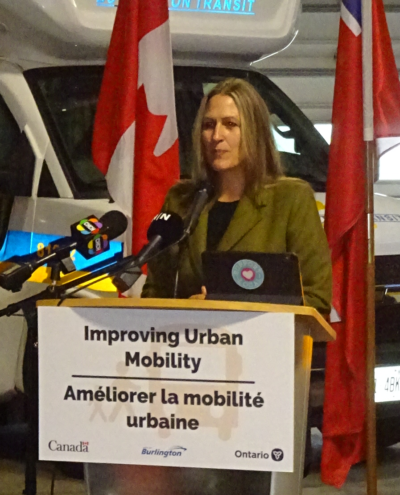
Mayor Marianne Meed Ward celebrating the arrival of another new bus. She had people literally dancing around when she finished speaking.
A report that will go to Council next week back more than suggests city council got this one right.
The report provides information/data on ridership regarding seniors, youth and SPLIT Pass as well as estimated costs and implementation matters that would need to be considered for future discussions around free transit for youth all day, every day.
The Community Planning, Regulation and Mobility Committee had a report on the feasibility on free transit for seniors (65+ years of age) all day, every day, and free transit for youth (13 – 19 years of age) during evenings after 6pm and all hours on weekends.
At the same meeting the Committee requested Transit staff to provide additional information and ridership data for seniors, youth and Subsidized Passes for Low Income Transit (SPLIT), as well as cost estimates and implementation considerations for fare free transit for youth all day, every day.
Staff reported that there are many variables to take into account when considering significant changes to transit fares. This includes resources, capacity, plans, along with future needs and any funding requirements. The following information is provided with this in mind.
In September 2019, Burlington Transit restructured bus routes across the city towards a grid network, providing more frequency along major arterial roads. During the six months after the network change, ridership increased by 14% from September 2019 to February 2020. In March 2020, the pandemic was declared, and ridership was negatively impacted. Due to these variables, 2019 is established as the comparator year to understand how ridership is changing.
Overall ridership in 2020 plummeted by 39%. 2021 ridership remained 36% below 2019 ridership. In 2022, as COVID-19 pandemic restrictions were lifted, overall ridership increased; however, remained 9% lower than 2019 ridership.
Table 1 outlines actual and projected total ridership, broken out by concession fare categories. 2019 – 2022 provides actual ridership and the average percentage of ridership by concession. Historically, adults make up approximately 80% of all ridership, with the remaining 20% made up from child, youth and senior demographics combined. 2023 and 2024 illustrate estimated ridership and projected ridership growth based on historic concession percentages.
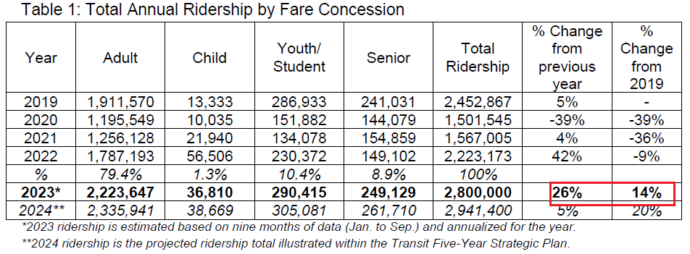

The dress code for Council members during the tough Covid19 days.
Since the pandemic, Burlington Transit has returned to the ridership growth curve that was projected in the Transit Five-Year Strategic (“Plan”) (2020-2024). In 2023, overall ridership is estimated to reach 2.8 million or approximately 14% increase from 2019 (pre-pandemic) ridership. The 2.8 million is in keeping with the anticipated total ridership provided to Council in the Plan and is consistent with planned ridership target of 2.9 million in 2024. In Table 1 above, the 2024 total annual projected ridership is broken out by concession based on previous years’ ridership experience for estimated comparison.
Burlington Transit is currently experiencing ridership growth in line with planned and projected growth estimates. Any additional increase to ridership and boardings should be done in a strategic and planned approach.
The following sections provide Council with an update to existing free fare initiatives to date, including the planned SPLIT and Senior free fare, along with Youth free fare during weekdays after 6:00pm and all hours on weekends.
- Subsidized Passes for Low Income Transit (SPLIT) Program
SPLIT Pass usage accounts for approximately 5% of Burlington Transit’s total ridership, which is currently represented by 70% adults, 21% seniors and 9% youth.
Since August 1, 2023, seniors started to travel for free at all times and are no longer required to apply for any subsidy for public transit in the City of Burlington. It is also important to note that SPLIT usage changes from year to year and is guided by many community factors such as an individual’s circumstances, current economy, employment, etc.
- Free Transit for Seniors (65+ Years of Age)
Senior ridership demographic equates to 9% of total ridership for the City of Burlington. Starting May 2019, the Senior Free Midday fare pilot was introduced, and senior ridership initially increased by 41% during the first nine months (June 2019 to February 2020) of the pilot, until the pandemic.
As illustrated in Table 2 below, in 2020 overall senior ridership fell by 40% due to pandemic restrictions, and from 2020 to 2022, Burlington Transit did not see a return to pre-pandemic senior ridership levels. In 2023, based on the first nine months of ridership data, senior ridership is making a recovery to pre-pandemic levels with an estimated 3% increase from 2019.

The current trend for senior ridership is reporting 27% higher in August 2023 from August 2019, and 28% higher in September 2023 from September 2019.
Seniors continue to travel during off-peak demand time of the day, which has minimal impact to ridership capacity during peak demand in the early morning and late afternoon/early evening hours. This is represented in Graph 1 below.
Senior free fare was approved by Council (TR-04-23) and the estimated $160,000 in lost revenue has been incorporated into the 2024 Financial Needs and Multi-Year Forecast. The 2024 rates and fees for senior fare concession has been adjusted to reflect the $0 fare.
- Free Transit for Youth (13 – 19 Years of Age) Weekdays after 6pm and Weekends
Based on previous ridership data from 2019 – 2022, youth make up 10% of total Burlington Transit ridership. As shown in Table 3 below, again due to the pandemic, there was a reduction in youth ridership in 2020 and 2021. In 2022, youth ridership didn’t fully return to pre-pandemic levels; however, the data illustrates that when students returned to school and pandemic restrictions were lifted, this ridership demographic returned to using Burlington Transit to get around. Based on 2023 estimates, staff are anticipating a 1% increase in youth ridership from 2019.

Starting August 1, 2023, youth started to travel for free on Burlington Transit during weekdays after 6pm, and all hours on weekends. The free fare for youth was recommended to allow seniors to travel for free at all times, due to constraints of the PRESTO system, which can only support a single time of day concession. The youth free fare weekday and weekend hours were decided to ensure that weekday ridership capacity would not be negatively impacted.
Historically, data illustrates that youth ridership is lower during the months of July and August and increases in September to June of each year. This is consistent with ridership increasing during active school months.
Current trends are consistent with past experience showing that youth riders have returned to using Burlington Transit due to school starting in September. Table 4 below illustrates how youth use Burlington Transit during school months and less during the summer months. Staff are continuing to review ridership data to get a comprehensive understanding of how free ridership after 6pm on weekdays and all day on weekends is being used by this ridership demographic. At this time, there are only two months of reported free ridership data, which is not enough to get a full understanding of how free fare is influencing the use of transit. Staff will continue to monitor and share information with Council.

Implementing expansion to free transit for youth all day will require additional service during these peak periods, necessitating an expansion to Burlington Transit’s bus fleet. The estimated fiscal impact is included in the financial impact section below.
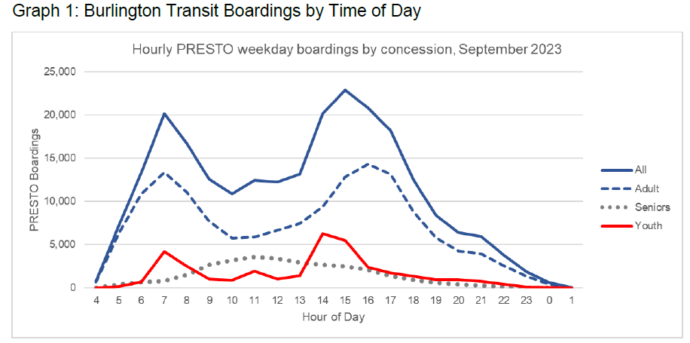
Prior to any additional or expansion of free fares, Burlington Transit would recommend that a phased approach be considered to establish the foundation to support transit service delivery. The first phase would be to complete the implementation of the Transit Five-Year Strategic Plan. The second phase would be to work with a consultant to conduct a comprehensive analysis to include budgetary impacts, transit service requirements, PRESTO contract obligations, environmental benefits, and more. This would establish a strategic plan and objectives for any potential changes to ensure quality of transit service. The third phase would be to further review the Operating Metrolinx Agreement and the City’s decision to renew the contract in 2027.
Implementation of Burlington Transit Five-Year Strategic Plan
Burlington Transit is currently working to fully implement the strategic objectives of the Transit Five-Year Strategic Plan (2020-2024). The strategies and initiatives defined in the Plan were established to allow for flexibility in timing and financials due to COVID-19 and the City’s recovery from the global pandemic. Full implementation of the Plan has been delayed due to various reasons; however, it is an important first phase to complete this Plan before additional expansion of free fare ridership is considered. Council endorsed this plan in December 2020, following discussions and adaptations of the Plan to ensure transit ridership growth and service was practical and sustainable.
This Plan is a living document and provides the strategic roadmap to encourage continued ridership growth and the investment to support this growth. 2023 is the first year since the pandemic that Burlington Transit has returned to full service and is able to shift focus from adapting to a pandemic to implementing the strategic initiatives of the Plan. While 2024 is the last year of the Plan, many of the strategic objectives will continue to be included in future years’ budgets and built on as part of the next Five- year Plan.
Preliminary Analysis, Strategic Approach and Financials to Provide Free Transit for Youth
Additional infrastructure and resources would be required to support youth free fare and the increase in ridership demand. Before any additional or expansion to free fares is considered, a full and comprehensive review and strategic approach is required to ensure continued quality of transit service. In order to provide Council with the requested information and cost estimates for youth free fare at all times, the following information is provided with two months of youth free ridership (weekdays after 6pm and weekends) experience.
Estimated Youth Ridership Increase and Risk
Based on the number of high school students who are currently not eligible or provided school bus transportation by the school boards in Burlington, free transit would result in a significant increase in annual youth ridership, which is estimated to be up to 1.1 million in boardings. This is based on 187 active school days within a school year. It is necessary to estimate the number of anticipated boardings to understand the potential demand in relation to capacity.
At this time, within existing resources, Burlington Transit does not have the capacity to add school specials or additional buses to routes that service high schools. Based on the expected increase in boardings and to accommodate this extra growth in ridership, it is estimated that additional infrastructure and staffing resources would be required to service this demand. It is important to note this would be in addition to the planned increase in staffing outlined in the Transit Five-Year Plan, illustrated in Table 6.
To sustain operations and provide free transit for youth at all times, the following additional resources and staff positions would be required to properly deploy this program:
- Four additional conventional buses
- Eight Operators
- One Rider Experience and Education Specialist
- One Operations Supervisor
- One Mechanic
Prior to any additional free fare programs being expanded or introduced, it is recommended that a comprehensive analysis be conducted. This would be part of the consultant review approved by Council through Staff Direction to report back in Q4 2024 (SD-31-23).
Operating Agreement for PRESTO By and Among Metrolinx (Nov. 2027)
Furthermore, the City of Burlington currently has contractual obligations through the Operating Agreement for PRESTO By and Among Metrolinx until November 2027. The contract binds the City to use only PRESTO as a fare payment system. A fare amount can be $0; however, a transit agency is required to achieve an adoption rate and aggregate fare revenue that is generated based on annual revenue ridership.
When staff consider the commitment to minimum revenue outlined in the Agreement, it will be necessary to better understand the financial impact to additional free fare and the PRESTO Agreement. This will be carefully reviewed with finance, corporate legal and PRESTO to ensure any additional fees required to be paid by the City of Burlington is considered as part of the financial impact provided in Q4 2024. The PRESTO contract and fare integration impacts are outlined in the work that will be undertaken by the consultant, as per Staff Direction SD-31-23.
Transit Five-Year Strategic Plan – Capital and Operating Budget Investment
As previously noted, the Five-Year Plan has not been fully implemented, which includes the planned expansion of conventional buses from 63 buses in 2019 to a total of 79 buses by 2024 to support planned service and ridership growth. The last remaining eight expansion conventional buses are currently included in the Financial Needs and Multi-Year forecast for funding of four buses in 2024 ($4,045,000) and four buses in 2025 ($4,329,000). Capital Project VE-VN-1503 provides the total financial impact of
$8,374,000. The planned expansion is partially funded through ICIP, with a total committed amount of $6,141,000 in approved funding.
It is important to note that a conventional bus takes one year to 18 months from procurement to delivery. Based on this timing, it will be 2026 to 2027 before the planned expansion for conventional buses is completed.
Lost Revenue
In addition to the expenses noted above, it is estimated that there would be a loss in revenue of $580,000. This is based on the youth ridership and 2024 planned budget for fare concession revenue. This has not been included in the 2024 Financial Needs and Multi-Year Forecast.
Total Financial Impact
The total financial impact to provide free fare transit for youth is summarized below. The total fiscal impact includes the capital investment, ongoing operating investment and anticipated revenue loss.
Table 9: Youth Free Fare Budget Estimates
| Description | Operating $ | Capital $ |
| Capital Infrastructure – 4 Additional Conventional Buses | – | $4,188,000 |
| 11 Additional FTE to Support Youth Free Ridership | $1,680,000 | |
| Lost Revenue | $580,000 | |
| Estimated Sub-total | $2,260,000 | $4,188,000 |
The total cost to implement free transit to youth demographics is estimated to be
$6,448,000. These costs are not currently included within the Financial Needs and Multi-year Forecast, and do not include associated operating costs, like fuel and maintenance. These costs are also in addition to full implementation of the Transit Five- Year Plan, which is still underway.
Source of Funding
The source of funding is unknown at this time, as all funding under the ICIP program has been allocated to the implementation of the Transit Five-Year Plan. Other transit funding sources such as Provincial and Federal Gas Taxes are currently dedicated to the renewal of the existing fleet.
Halton School Boards are provided provincial funding for student transportation. It would be beneficial to include this in the consultant’s work to better understand any potential funding opportunities if the City is going to provide transit service where dedicated school bus transportation is provided, or partially subsidize public transit as a service to the school boards.
Other Resource Impacts
As noted above, the human resource impacts of implementing a free fare program for students would require additional support staff. Specifically:
- Transit Operations Supervisors to support additional capacity on buses, provide assistance at schools and to troubleshoot potential concerns and issues that
- Rider Experience and Education Specialist is required to support travel training and student transit education program. This resource would plan and develop the travel training program and work with school boards to support travel
- Transit Operators to support the increase in service hours required for increased transit service.
- Transit Mechanics to support additional infrastructure and increase Other costs of the program may include:
- Increased maintenance costs due to expanded service hours, which would result in additional staffing.
- Fuel costs due to increased service
- Additional maintenance costs to buses due to increased service
Risks
Providing youth free fare transit at this time, without planned investment, has the potential to create the following risks:
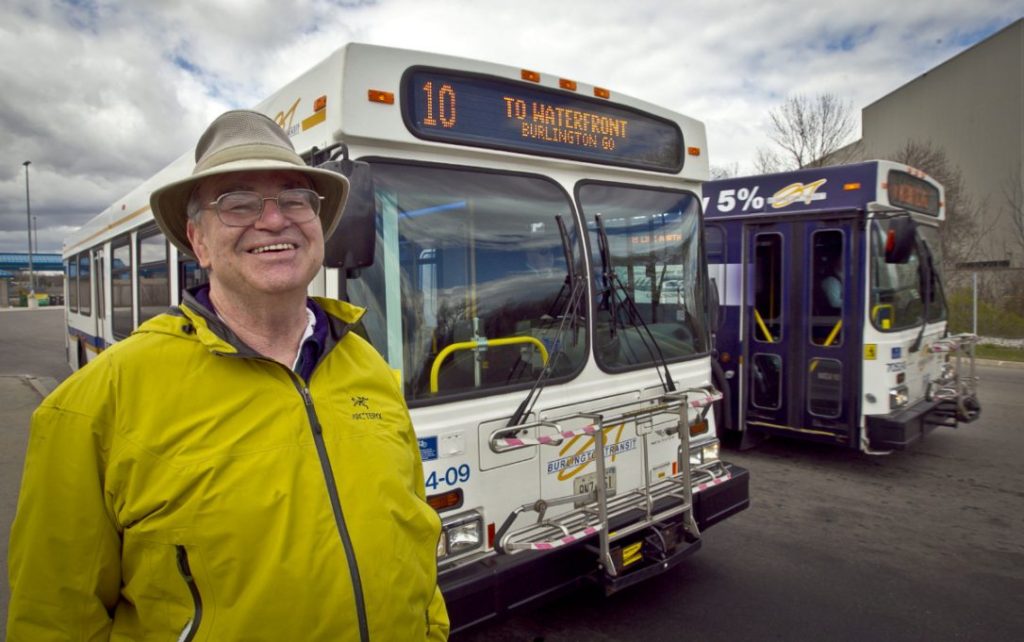
Doug Brown may soon wear an even bigger smile
Overcrowded buses during peak periods and the potential of leaving people behind,Schedule delays from buses operating at crush loadsPoor customer service and increased complaints,
Unsafe conditions due to overcrowding,
Burlington Transit and the City’s reputation,
City’s obligation to the PRESTO Operating Agreement,
Reduced ridership due to poor customer service,
Increased problematic behaviour due to overcrowding, decline in service,
Public transit supports the City’s targets to reduce carbon dioxide (CO2) emissions. Every ride on Burlington Transit removes a car off the road and reduces CO2 emissions and traffic congestion.
Each 40-foot bus (12.2 metres) seats 40 riders comfortably; however, can hold up to 60 passengers with standing room. Considering annual ridership totals divided by 40 riders provides staff with an average estimate of personal vehicles removed from roadways. Based on 2023 anticipated ridership, it is estimated that Burlington Transit will remove 70,000 single trip vehicles from the roadways.
Staff have started conversations with the City’s finance department to better understand the full financial impact of free transit on the transit operating and capital budget.
To have a fulsome youth transit program, engagement with Halton School Boards at a political level is required to re-initiate the conversations that were started in 2019. The purpose would be to discuss funding opportunities to offset some of the costs to offer this program.
It is estimated that full implementation will not take place prior to 2027, based on the Financial Needs and Multi-year Forecast.
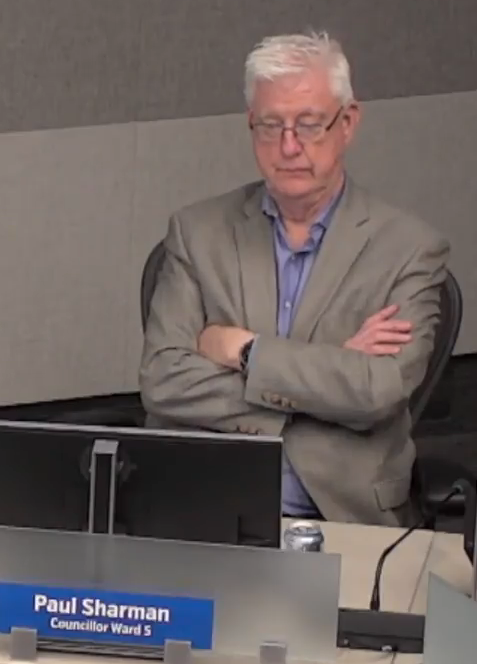
Funding free transit – will he support it? Hasn’t been a transit fan in the past.
Also, that any expansion of free fare programs be deferred until after the consultant study is completed. The consultant study will examine any associated costs, benefits and risks, impact to financial sustainability, service impacts, and potential funding sources, and will be provided to Council in Q4 2024, as per Staff Direction (SD-31-23).
Lastly, that the existing PRESTO Agreement be considered in regard to timing of any additional or expansion of free fare changes due to the City’s contractual obligation.
Mayor Meed Ward has wanted free transit for everyone at any time of day.
She gets full credit for this one and deserves full support from every member of Council
Councillor Sharman might choke on this one – do it for the Gipper Councillor.
















Burlington’s commitment to public transit, like its commitment to citizen engagement, fiscal prudence and transparency is so much ‘smoke and mirrors’ – empty rhetoric and ‘communications form over operational substance’. I will give one example from recent experience.
My wife of 52 years went into long-term care in August. We are having the expected difficulties adjusting to the situation but we shall. Obviously, I want her to come home for Christmas but cannot afford extended 7×24 support arrangements. A reasonable compromise would see her come home for Christmas Eve (our traditional Christmas dinner), return to care then come back for the day on Christmas day. It will be the first time in 52 years that we have not greeted each other first thing on Christmas morning but our lives have changed and we will adjust. Given our situation I find that the fundamental presumptions of Burlington’s transit system are nonsense as are those claiming our Mayor and Council are champions of free access, dependable service and citizen accessibility. Not when you look at the operational realities.
As it stands now, Burlington’s specialized transit services will not schedule rides for the disabled prior to 14 days before the date. They claim that it is “the system” by which they mean, these are the operating parameters that they have been given and they will not deviate. So, I need to be amongst the first to call on December 10th and 11th to ensure that my wife gets her transport and is able to spend some of Christmas at home. From my perspective, it is far less important to have a free service than it is to have one that is dependable, ‘there when you need it’ and is based on client needs – which include predictable scheduling. I will gladly pay for such.
Anne has lived with a significant disability since birth. Back in 2005 she was unable to do anything bur lie in bed that shook all the time with the spasms she had to tolerate. She was diagnosed with Strychnine poisoning by a Naturapa, the t
The tol one in Ontario at the time… We had to put her mom back in Ltc. As Anne needed PSW care herself. We had brought her home and taken her to Australia and England after 14 years in residential care living first old age home then ltc. She was doing great. She died within the year. Anne’s recovery to a more independent state took until 4 years after Eva passed.
We had to depend on city provided handivan etc. For hospital, rehab and other apps as Dave did not retire until 2010. We had the same issues Blair, this is not a city who are compliant with AODA rules and really don’t care that they don’t. We know how difficult it is for families and will continue to advocate for such as a top priority for what we should have to serve the need. No need to be free for those who can afford but a must for all those now turning to food banks and terrified at every property tax in raise.
I believe there are few things that would help with rider uptake. One being zone rates or on/off rates. As to “free lunches” and “free transit” there is NO such thing. Let’s call this what it is “Taxpayer Funded” bus rider subsidization.
EDITOR’S NOTE: A little balance please. We can’t build anymore roads but we are going to add 50,000 people to the population and those people will want to drive to places. The city realizes what it is up against and are looking for a way to make it possible for people to get around.
Making it no cost to the rider is part of getting some balance. Dump the phrase “free” and try ‘no cost to the rider’.
Dear Editor: The meaning of “free is, “without cost or payment”. Using “free” in this context is misleading. Using the phrase, “no cost to the rider” is at least honest. Many if not most of Burlington Transits’ operating costs and capital costs are, ”sunk-costs”. If you understand that businesses as well as municipalities have sunk- costs then perhaps the case for having some people ride at no cost to them makes sense. As citizens what do we prefer, seeing buses riding around with 10% occupancy while taxpayers absorb the sunk costs, or, see that some citizens benefit from being able to ride at no cost to them.
Adding non paying ridership skews the numbers and makes it almost impossible to draw a reasoned conclusion. The term free transit should never be used. Somebody is paying.
Jim, you are absolutely right–there is no “free transit”. Taxpayers, the residents that MMW doesn’t care about, are picking up the tab for her agenda.
these numbers mean nothing to me.I would like to see the utilization rates.AlI have ever seen apart from G train traffic is empty buses Do we really need bus service at all?